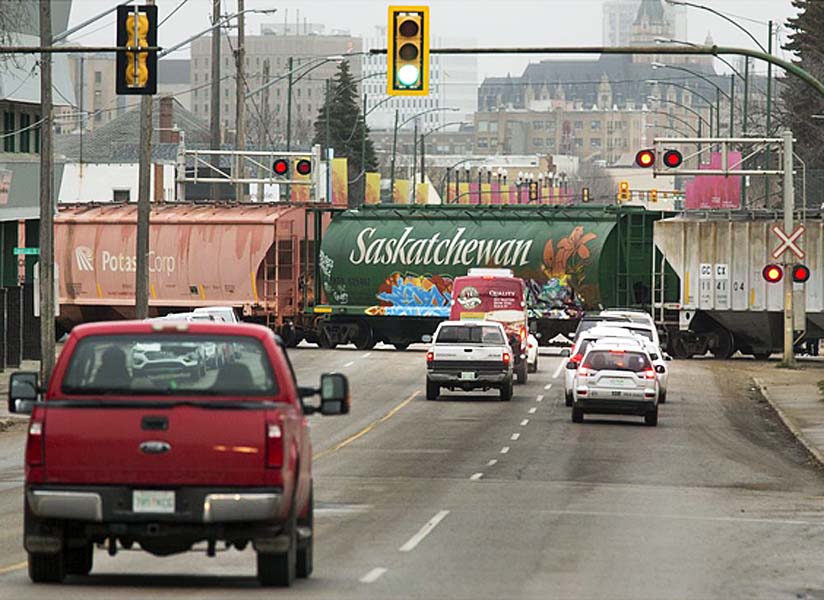
Saskatoon Saskatchewan - Derailed.
On the wrong track.
A train wreck.
Use whichever metaphor you like to describe the rejection by Canada's two main railway companies of the most recent proposed solution for rail delays in
Saskatoon.
If you'll excuse one more, the train has yet to leave the station.
City hall had proposed that both Canadian Pacific Railway Ltd. (CP) and Canadian National Railway Co. (CN) share the main CN line that runs south of
Saskatoon.
The railways responded in very clear terms.
CN called the idea "not feasible," while CP dubbed it "fundamentally unworkable."
There seems to be no solution on the horizon for trains that delay vehicle traffic in Saskatoon, despite the high financial cost.
A 2016 report by the Saskatoon Regional Economic Development Authority suggested train delays, using information gathered in 2014 and 2015, were costing city
businesses $10,000 a day or $2.54 million a year in lost economic activity.
That means more than $10 million lost since the study.
In 2018, a consultant hired by city hall put numbers on two possible solutions.
The cost of removing the CP line was estimated at $589.7 million.
That's far lower than previous estimates that put the cost in the billions, but still prohibitive, with nobody eager to shell out that cash.
And it would only remove the main CP line, not the remaining CN tracks.
The cost of building underpasses and overpasses at nine locations was pegged at $374.4 million.
This option was rejected by city hall's administration due to the disruptions needed for construction, although city council eventually decided to keep all
options open.
The economic benefits of relocating the CP line were estimated at $392.1 million over 30 years, while the benefits of nine underpasses/overpasses was forecast
at $218 million.
So the net cost of CP relocation was pegged at $197.6 million, while the net cost for underpasses/overpasses is $156.4 million.
The administration noted that relocation would bring other benefits, like the end of trains hauling dangerous materials through the city.
It goes beyond that, though.
Train tracks cross roadways that are key to the city's proposed bus rapid transit style revamp, including 22nd Street, Idylwyld Drive, 25th Street, and Preston
Avenue.
Increased transit service along certain corridors is also key to the city's plan for a new downtown arena and entertainment district.
And so on.
Incumbent Mayor Charlie Clark changed his mind midway through the current term and decided rail relocation had emerged as the better option.
During the 2016 mayoral campaign, Clark opposed rail relocation as too expensive and unrealistic.
He suggested the underpass/overpass route, which seems likely to become the new focus at city hall.
In 2018, Clark admitted he was surprised by the high cost of building overpasses and underpasses, but described relocation as a "long-shot kind of
discussion."
Clark would have undoubtedly welcomed a positive response from the two railway companies as a competitive election looms on 9 Nov 2020 with five other
candidates seeking to replace him.
City hall's claim that technology will help alleviate the impact of train delays will prove a hard sell.
Meanwhile, former mayor Don Atchison is sticking to his position from 2016 to keep pushing for rail relocation, with no real strategy yet
outlined.
The four city hall outsider mayoral candidates, Rob Norris, Zubair Shiekh, Cary Tarasoff, and Mark Zielke, can point to 17 years of combined failed leadership
by Clark and Atchison to address train delays.
But all claims on railway delays should be viewed skeptically.
It's easy to support rail relocation, yet much tougher to explain how to achieve it.
It's worth noting that Regina also has rail lines slicing through it, but has built five underpasses so motorists have an option to avoid delays.
Saskatoon features railway overpasses/underpasses along Circle Drive, Idylwyld Drive, and College Drive, but none of these is centrally located.
You can argue that Saskatoon has been compelled to spend money on bridges instead.
But with the $211.4 million Chief Mistawasis Bridge hosting thousands fewer vehicles than expected, you can question whether that money might have been better
spent elsewhere.
Phil Tank.
(because there was no image with original article) *2. Original news article image replaced.
(usually because it's been seen before)
provisions in Section 29 of the Canadian
Copyright Modernization Act.

